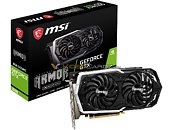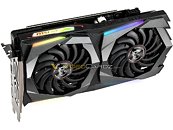Raevenlord
News Editor
- Joined
- Aug 12, 2016
- Messages
- 3,755 (1.15/day)
- Location
- Portugal
| System Name | The Ryzening |
|---|---|
| Processor | AMD Ryzen 9 5900X |
| Motherboard | MSI X570 MAG TOMAHAWK |
| Cooling | Lian Li Galahad 360mm AIO |
| Memory | 32 GB G.Skill Trident Z F4-3733 (4x 8 GB) |
| Video Card(s) | Gigabyte RTX 3070 Ti |
| Storage | Boot: Transcend MTE220S 2TB, Kintson A2000 1TB, Seagate Firewolf Pro 14 TB |
| Display(s) | Acer Nitro VG270UP (1440p 144 Hz IPS) |
| Case | Lian Li O11DX Dynamic White |
| Audio Device(s) | iFi Audio Zen DAC |
| Power Supply | Seasonic Focus+ 750 W |
| Mouse | Cooler Master Masterkeys Lite L |
| Keyboard | Cooler Master Masterkeys Lite L |
| Software | Windows 10 x64 |
Details on NVIDIA's upcoming mainstream GTX 1660 graphics card have been revealed, which will help put its graphics-cruncinh prowess up to scrutiny. The new graphics card from NVIDIA slots in below the recently released GTX 1660 Ti (which provides roughly 5% better performance than NVIDIA's previous GTX 1070 graphics card) and above the yet-to-be-released GTX 1650.
The 1408 CUDA cores in the design amount to a 9% reduction in computing cores compared to the GTX 1660 Ti, but most of the savings (and performance impact) likely comes at the expense of the 6 GB (8 Gbps) GDDR5 memory this card is outfitted with, compared to the 1660 Ti's still GDDR6 implementation. The amount of cut GPU resources form NVIDIA is so low that we imagine these chips won't be coming from harvesting defective dies as much as from actually fusing off CUDA cores present in the TU116 chip. Using GDDR5 is still cheaper than the GDDR6 alternative (for now), and this also avoids straining the GDDR6 supply (if that was ever a concern for NVIDIA).





The reference clock speed of GTX 1660 non-Ti is expected to be 1530/1785 MHZ. Custom models, such as the pictured GAMING X, will boost up to 1860 MHz. All graphics cards feature a single 8-pin power connector for increased power delivery. It's expected the GTX 1660 will launch on March 14th, at the $219 mark.
View at TechPowerUp Main Site
The 1408 CUDA cores in the design amount to a 9% reduction in computing cores compared to the GTX 1660 Ti, but most of the savings (and performance impact) likely comes at the expense of the 6 GB (8 Gbps) GDDR5 memory this card is outfitted with, compared to the 1660 Ti's still GDDR6 implementation. The amount of cut GPU resources form NVIDIA is so low that we imagine these chips won't be coming from harvesting defective dies as much as from actually fusing off CUDA cores present in the TU116 chip. Using GDDR5 is still cheaper than the GDDR6 alternative (for now), and this also avoids straining the GDDR6 supply (if that was ever a concern for NVIDIA).





The reference clock speed of GTX 1660 non-Ti is expected to be 1530/1785 MHZ. Custom models, such as the pictured GAMING X, will boost up to 1860 MHz. All graphics cards feature a single 8-pin power connector for increased power delivery. It's expected the GTX 1660 will launch on March 14th, at the $219 mark.
View at TechPowerUp Main Site







